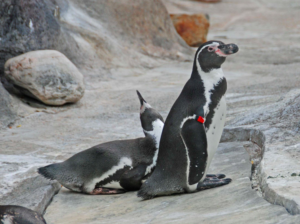Happy New Year! My name is Keiya Akiyama, and I am an undergraduate research assistant in the Parks Lab. Ever since I came to Syracuse University with a strong passion for becoming a veterinary surgeon, I always wanted to be part of a biological research that involves studying animals. Therefore, when I first found out about the Parks Lab, I printed out my resume and went straight to Dr. Parks’ office in the Life Science Complex despite my lack of knowledge in the field of bioacoustics.
Over the course of the last two years, I learned so much about bioacoustics through reading a number of articles related to the field as well as getting involved in the NEON project in the lab. In late 2015, I was thrilled to be introduced to the idea of conducting my own project on the penguins at the Rosamond Gifford Zoo in Syracuse, NY. However, due to many steps I needed to take in order to make this research possible, it took almost a year to actually start working on this project. I could not have done this without Dr. Parks and Holly (one of the postdoctoral researchers last year), who helped me through the process tremendously.
The objective of this research is to study the acoustic repertoire system of the Humboldt penguin (Spheniscus humboldti). My focus of this study is to quantify the species’ acoustic repertoire and to specifically measure within- and between-penguin variation in signal production and assess the potential for vocal individual discrimination and study their vocal ontogeny. Later, I will compare the results with previous publications describing the vocal signatures of other nesting and non-nesting penguin species.

We started our official, weekly data collection process in September 2016, after getting permission from the zoo. There are thirty-seven penguins in the studied captive colony, in which six of them are chicks that were hatched last March. Every Friday, Alexandra (another undergraduate assistant who has been helping me so much with the data collection) and I go to the zoo to collect audio and video data, utilizing recorders placed near the penguin exhibit. We are expecting the data collection to last for approximately one year while simultaneously identifying the callers and analyze the collected data in the lab.
Even though there are some modifications to be made in our data collection, we have been able to collect different data sets from different individuals within the colony. This year, we are hoping to eventually collect more data from individuals, from whom we have not been able to record calls. Once an adequate amount of data is collected for analysis, we will start measuring variation of signal production and looking at distinctiveness of certain call types at different age levels.
Conducting a bioacoustics research is tough, and there are a lot more for me to learn. However, the exposure I get from this research is very unique, and it is a once in a lifetime opportunity to work with marine mammals like the penguins. I look forward to continuing working on this project and hopefully to issuing publications from the study in the future!
– Keiya